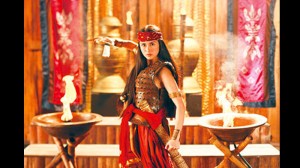Revisiting history on prime-time TV can be tricky, to say the least

“Amaya” has been criticized for historical and cultural “inaccuracies” but its head writer, Suzette Doctolero, points out that it “is a work of historical fiction.”
Historical fiction has caused friction.
The GMA 7 prime-time series “Amaya” has been put to task by authorities for historical and cultural “inaccuracies.” Anthropologist Dr. Alicia Magos said the use of the word “binukot,” “[if] detached from proper historical and cultural context … may be deceptive.”
Federico Caballero, an elder of the Panay-Bukidnon community and National Living Treasure awardee of the National Commission for Culture and the Arts, raised concerns over the depiction of the binukot (well-kept maiden) in the TV story, specifically her transformation into a warrior and her donning skimpy costumes.
Suzette Doctolero, “Amaya” head writer, told the Inquirer that the creative team took pains to research the show’s historical background. “We consulted various literary works, among them the book of William Henry Scott and the dissertation of Bernadette Abrera.” When she was in school, she said, “the pre-colonial period was tackled only fleetingly. We had no idea of our roots as a people.”
‘Revisionist’
With “Amaya,” Doctolero said, the network aimed to address this oversight via the popular genre that is prime-time soap. “In my research, I discovered that the pre-Hispanic period is a gold mine of stories. We want the audience to realize how rich our past is.”
As for the criticisms, Doctolero reiterated, “‘Amaya’ is a work of historical fiction.” But she noted that binukot were common in pre-colonial Philippines and in other Southeast Asian and Austronesian countries. And the scantily clad characters? She said: “Before the Spaniards came, our people had no malice about nudity. And logically, if a pre-Hispanic binukot is inside her home, there’s no reason for her to be all dressed up.”
Dennis Marasigan, “Amaya” movement director, insisted: “It’s revisionist history.” He pointed out that the production consults experts. “We have two consultants from the University of the Philippines History Department, Neil Santillan and Vicente Villan. We have a choreographer, Marciano Viri of the Ramon Obusan Folkloric Group. We taught the actors how to hold the “kampilan” (sword) and the “kalasag” (shield).”
When in doubt and when there are no historical records, Marasigan said, “we ask our consultants.” The rule of thumb: “It should be truthful within the world of the story.” As for the Spanish words in the script, he said, “We are open to feedback and we have informed the writers and actors to take extra care.”